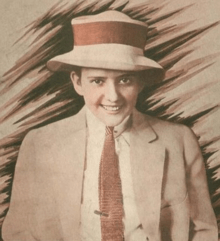Florence Tempest
Florence Tempest (born Claire Lillian Ijames, June 25, 1889 — died after January 1932), sometimes billed as Florenze Tempest, was an American comedian and dancer, a vaudeville and musical theatre performer, best known as part of "Sunshine and Tempest" with her sister, Marion Sunshine.
Florence Tempest | |
|---|---|
 Florence Tempest, from sheet music published in 1913. | |
| Born | Claire Lillian Ijames June 25, 1889 |
| Nationality | American |
| Other names | Florenze Tempest |
| Occupation | vaudeville performer |
| Years active | 1907-1932 |
| Known for | "Sunshine and Tempest", an act with her sister, Marion Sunshine |
Early life
Claire Lillian Ijames described herself as "born in Louisville";[1] other sources give Richmond, Virginia as her hometown.[2] Her parents were Edward Henry Ijames and Mary Henesey Ijames. About 1901, Mary Henesey Ijames moved to New York City as a widow, with her young daughters June (or Junie), Claire (or Clara), and Mary (or Marion). The sisters sometimes performed as a trio act.[3][4]
Career

Florence Tempest had a vaudeville act with her younger sister, Marion Sunshine; "I always played the boy, while Marion was my sweetheart", Tempest explained.[1] They toured with their mother. Tempest's act was admired not only for its humor but also for its technical ingenuity: "Florence Tempest has conceived and put into effect the most unique fashion of hair dressing for her boy characterization", commented one reviewer, "Her own front and side hair is combed into the wig and makes and excellent boy's pompadour without the suspicion of girlish coiffure."[5] The duo made a short silent film, Sunshine and Tempest (1915), in which they played telepathic twin sisters in the Tennessee mountains.[6]
Tempest also had a headlining solo act,[7] again playing masculine characters,[8] but also donning a gown as the only female character in her "College Town" act, with "Ten 'Rah-Rah' Boys" as her chorus.[9] She was described as vaudeville's "Most Lovable Boy and Daintiest Girl" in a 1917 headline.[10] She appeared on the cover art of sheet music in masculine suits and caps, in youthful poses, even smoking a cigarette; for "I Want a Boy to Love Me" (1913), she's shown lounging on a bench, a hand in her trouser pocket;[11] for "I Love the Ladies" (1914) she appears in a boater hat and the caption "Our American Boy".[12] In the 1920s, no longer suited to "boyish" characters, she was in a vaudeville act with her second husband, comedian Homer Dickinson; they were billed as "Broadway's Smart Couple".[13][14][15]They were still performing together as late as 1932.[16]
Florence Tempest appeared on Broadway in the shows Ziegfeld Follies of 1907 (1907), Little Nemo (1908-1909), H.M.S. Pinafore (1911), La Belle Paree (1911), Stop! Look! Listen! (1915-1916), and Earl Carroll's Vanities (1923). She also toured with the Ziegfeld Follies in the 1907-1908 season.[17]
Personal life
Florence Tempest married a theatrical agent, Joseph E. Shea, in 1915. They separated months later, and they divorced in 1920.[18] By 1924 she was married again,[19] to her vaudeville partner, Homer Dickinson.[20]
References
- "Orpheum Offerings" Western Magazine (April 1, 1920): 188.
- Emily Brokamp, "'You Ought to See Her Now': The Female Kings of the Music Hall and Vaudeville" Jerome Lawrence and Robert E. Lee Theatre Research Institute, Ohio State University Libraries.
- "Next Week's Orpheum Show" The Morning Examiner (January 2, 1910): 11. via Newspapers.com
- "Pretty Sisters in Act" The Fort-Wayne Journal-Gazette (May 9, 1910): 5. via Newspapers.com
- Jackson D. Haag, "Midweek in the Theatres: A Pleasing Sister Act" Pittsburgh Daily Post (April 12, 1912): 20. via Newspapers.com
- "Lyceum" The Allentown Leader (November 2, 1915): 8. via Newspapers.com
- "Florence Tempest Heads Savoy Bill" Asbury Park Press (October 24, 1913): 17. via Newspapers.com
- E. L. M. "The Town's Gossip" Detroit Free Press (September 27, 1917): 9. via Newspapers.com
- "Cool Air Without, Good Bill Within" The Brooklyn Daily Eagle (May 27, 1913): 28. via Newspapers.com
- "Most Lovable Boy and Daintiest Girl" Hartford Courant (October 5, 1917): 7. via Newspapers.com
- "Florenze Tempest: Male Impersonator" Queer Music Heritage website.
- "I Love the Ladies" sheet music, J. D. Doyle Archives, Digital Transgender Archive.
- Gillian M Rodger, Just One of the Boys: Female-to-Male Cross-Dressing on the American Variety Stage (University of Illinois Press 2018): 179-180. ISBN 9780252050169
- James Muir, "Five New Productions" Dayton Daily News (April 27, 1926): 17. via Newspapers.com
- "Colonial Opens its Vaudeville Season with Big Feature Act" The Akron Beacon Journal (August 23, 1924): 2. via Newspapers.com
- "Broadway Vaudeville Bill Opens at State Today" Reading Times (January 11, 1932): 9. via Newspapers.com

- Kay Green, ed., Broadway Musicals, Show by Show (Hal Leonard Corporation 1996): 14. ISBN 9780793577507
- "Florence Tempest Finds Tempest in her Married Life" The Oregon Daily Journal (August 22, 1920): 44. via Newspapers.com
- "Florence Tempest to Appear in Vaudeville at Hancock This Week" Austin American-Statesman (February 12, 1924): 5. via Newspapers.com
- Jamie Brotherton, Ted Okuda, Dorothy Lee: The Life and Films of the Wheeler and Woolsey Girl (McFarland 2013): 9. ISBN 9780786433636
External links
- Florence Tempest on IMDb
- Florence Tempest at the Internet Broadway Database
- Examples of Florenze Tempest sheet music, in Digital Commonwealth: Massachusetts Collections Online.